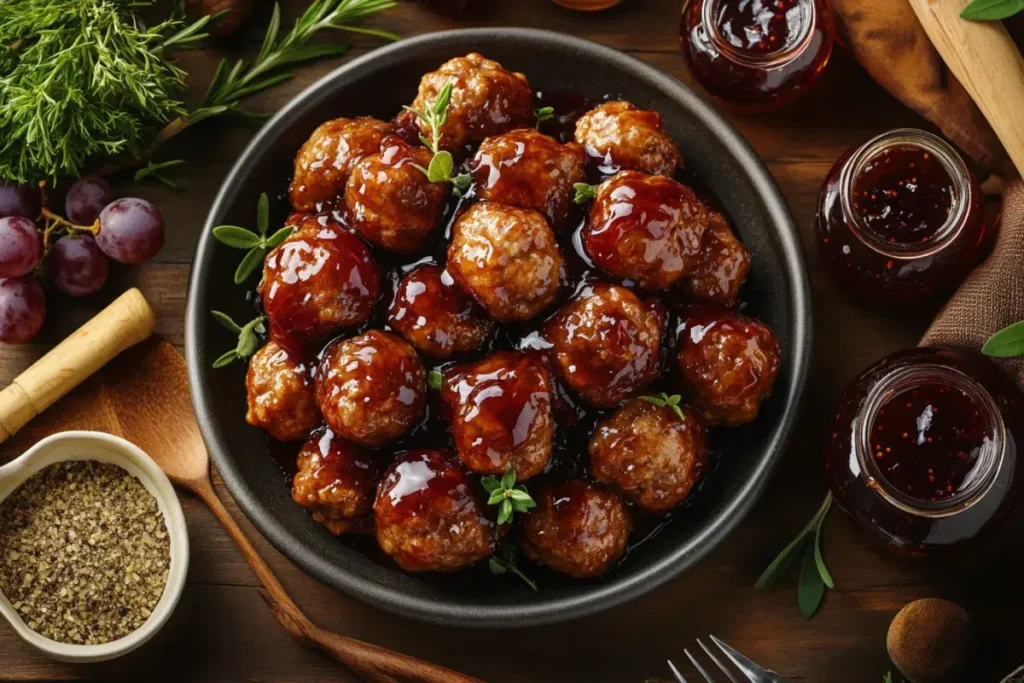If you’ve ever attended a potluck or holiday party in the U.S., you’ve likely encountered grape jelly meatballs. At first glance, the combination of sweet jelly and savory meatballs might seem odd, but it’s been a popular dish for decades. This iconic sweet and savory appetizer has earned a permanent spot in American kitchens. But why do people put grape jelly in meatballs? How did this unique dish become so popular? In this article, we’ll explore the history, cultural significance, and flavor science behind this quirky yet beloved recipe.
History and Origins of Grape Jelly in Meatballs
The idea of combining grape jelly with meatballs took off in the mid-20th century, especially during the 1950s and 1960s. During this time, convenience foods were becoming increasingly popular across American households. People were looking for quick and easy meals that required minimal prep time but could still serve a crowd. Grape jelly, a common pantry item, became a surprising ingredient in savory dishes like meatballs. The result? A sweet, tangy flavor that paired perfectly with the savory richness of the meat.
This recipe’s roots are deeply tied to broader trends in post-war American cuisine. Convenience foods like canned soups, frozen vegetables, and jellies became staples in the kitchen. For busy families, these products were lifesavers. Pre-packaged and easy to use, they could be combined with minimal effort to create filling, flavorful meals. This focus on quick meals helped grape jelly meatballs rise to prominence. The dish reflected the desire for convenient cooking while delivering a unique flavor that could feed large gatherings without too much hassle.
The Role of Convenience Foods in Mid-Century American Cuisine
The 1950s and 1960s saw a surge in the popularity of processed and pre-packaged foods. Families embraced these products because they made meal prep fast and simple. Grape jelly meatballs fit perfectly into this trend. With frozen meatballs and a jar of grape jelly on hand, anyone could whip up a party-worthy dish in no time. Convenience foods like these became the backbone of many popular recipes during this era, with grape jelly meatballs standing out as a prime example of how Americans adapted their cooking styles to fit their fast-paced lives.
Why People Combine Grape Jelly with Meatballs
Why do people combine grape jelly with meatballs? The answer lies in the remarkable combination of flavors. When sweet jelly meets savory meat, it creates a balance that’s hard to resist. This sweet and savory pairing has been a favorite in many cuisines worldwide. Think of dishes like sweet and sour chicken or honey-glazed meats. Grape jelly meatballs offer a similar flavor profile, combining the sweetness of the jelly with the richness of the meatballs.
- Flavor Balance: The sweetness of the jelly cuts through the saltiness and richness of the meatballs. This creates a balanced, flavorful bite that isn’t overwhelmingly sweet but hits just the right note.
- Tanginess: In most recipes, grape jelly is paired with a tangy sauce, such as chili sauce or BBQ sauce. This tangy element adds another layer of flavor, making the dish even more complex.
- Texture Enhancement: The jelly creates a sticky, glossy coating on the meatballs. This adds a rich texture that clings to each bite, making it an ideal appetizer. The sauce stays on the meatballs, making them easy finger food for parties and potlucks.
For more information on how sweet and savory flavors interact, take a look at this article discussing the science of flavor combinations.
The Role of Sweetness in Enhancing Meat Dishes
Using sweet elements in savory dishes is not as unusual as it might seem. From honey-glazed meats to fruit-based sauces, many recipes use sweetness to enhance the natural flavors of meat. Grape jelly serves this purpose in meatballs, adding a sweetness that brings out the umami in the dish. The jelly doesn’t overpower the meat but instead highlights its savory notes. This combination keeps people coming back for more.
How Grape Jelly Meatballs Became a Potluck Favorite
It’s no surprise that grape jelly meatballs became a potluck favorite. Their unique mix of flavors and ease of preparation made them perfect for parties. The recipe typically calls for just three ingredients: grape jelly, frozen meatballs, and a tangy sauce (like chili or BBQ sauce). All you have to do is toss them in a slow cooker, stir occasionally, and let the dish cook itself. This simple process makes it a convenient option when feeding a crowd.

Popularity Across the U.S.
Grape jelly meatballs are particularly popular in the Midwest and Southern U.S. regions, where potluck-style gatherings are common. These areas have a long tradition of hearty, easy-to-prepare dishes that can feed large groups. The meatballs became a staple because they’re both filling and flavorful. They offer a comforting blend of sweet, tangy, and savory flavors, making them a dish that pleases nearly every palate.
The simplicity of the dish also contributed to its enduring popularity. With frozen meatballs, a jar of grape jelly, and some sauce, anyone can make this dish, even those with limited cooking experience. Additionally, the recipe’s versatility allows for endless customization. For example, some people add sriracha for a spicy kick, while others prefer a milder flavor by using a fruit-based BBQ sauce. These small tweaks keep the recipe fresh and appealing for new generations of cooks.
Grape jelly meatballs may seem like an unusual dish at first, but their flavor, convenience, and history have made them a beloved part of American cuisine. The dish’s unique balance of sweet and savory has stood the test of time, with potlucks and parties across the U.S. continuing to serve it. The recipe’s simplicity, combined with its nostalgic appeal, ensures that grape jelly meatballs will remain a go-to dish for gatherings for years to come. Whether you’re looking for an easy party appetizer or just want to try something different, grape jelly meatballs offer a fun and flavorful option.
Variations of Grape Jelly Meatballs
While the classic grape jelly meatball recipe calls for only three ingredients — grape jelly, meatballs, and a tangy sauce like chili or BBQ — there are countless ways to customize this dish. Over the years, cooks have experimented with different flavors and combinations, leading to several creative variations. Whether you’re looking for something spicy, smoky, or even a bit healthier, there’s a version of grape jelly meatballs for everyone.
- Classic Version: The original recipe typically involves frozen meatballs, grape jelly, and a tangy sauce. This is the most straightforward version and is still popular today for its simplicity and nostalgic flavor. You can find the full grape jelly meatballs recipe here for more details on ingredients and preparation.
- BBQ Grape Jelly Meatballs: A popular variation swaps out chili sauce for BBQ sauce. This version adds a smoky flavor to the sweet jelly, making the dish even more dynamic.
- Spicy Grape Jelly Meatballs: Some cooks add a dash of hot sauce or sriracha to give the dish a spicy kick. This variation is great for those who prefer a bit of heat in their food.
- Healthier Alternatives: To make the dish lighter, some people opt for leaner meats like ground turkey or chicken instead of traditional meatballs. You can also use sugar-free grape jelly to reduce the sugar content without sacrificing flavor.
The Most Popular Ingredients for Grape Jelly Meatballs
At the heart of this dish are the three main ingredients: grape jelly, meatballs, and a tangy sauce. But many cooks have come up with alternative ingredients to suit their tastes. Here’s a breakdown of the classic and popular alternatives:
- Grape Jelly: This is the star ingredient, providing the sweetness that balances out the savory meatballs. However, some people prefer to use other fruit jellies, like cranberry sauce or apricot preserves, for a slightly different flavor.
- Meatballs: While frozen meatballs are the most convenient option, some prefer to make homemade meatballs with leaner meat or even plant-based alternatives for a healthier twist.
- Tangy Sauce: Chili sauce is the traditional choice, but BBQ sauce, sriracha, or even mustard can be used to give the dish a new flavor profile. Some people also mix in ketchup or tomato-based sauces for a richer taste.
Grape Jelly Meatballs: A Symbol of American Fusion Cuisine
While grape jelly meatballs might seem purely American, they actually represent a fascinating blend of culinary traditions. The dish combines European-style meatballs with the American love for sweet and savory flavors, along with the convenience of processed foods. This type of fusion cuisine is common in the U.S., where different cultural influences come together to create new dishes. Just as Asian-inspired sweet and sour sauces have become popular in American cooking, grape jelly meatballs have carved out their own niche in the country’s culinary landscape.
In many ways, the dish symbolizes the innovation that comes from combining unlikely ingredients. What started as a quick, throw-together party food has become a beloved staple at potlucks and gatherings across the country. This fusion of flavors highlights America’s culinary diversity, blending old-world techniques with modern convenience foods.
How to Make Grape Jelly Meatballs: A Step-by-Step Guide
Making grape jelly meatballs is incredibly simple, and part of the dish’s popularity stems from how easy it is to prepare. Here’s a quick guide to making the classic version of this beloved appetizer.
Ingredients:
- 1 bag (32 oz) of frozen meatballs (or homemade meatballs)
- 1 cup of grape jelly
- 1 cup of chili sauce or BBQ sauce
Instructions:
- Combine Ingredients: Place the frozen meatballs in a slow cooker. Add the grape jelly and chili sauce or BBQ sauce on top.
- Mix and Cook: Stir the ingredients to coat the meatballs evenly with the sauce. Cover and cook on low heat for 4-5 hours or on high for 2-3 hours. Stir occasionally to ensure the meatballs are evenly coated with sauce.
- Serve: Once the meatballs are heated through and the sauce is thick and glossy, transfer them to a serving dish. They can be served straight from the slow cooker or transferred to a platter for easy serving.
Cooking Tips:
- Slow Cooker vs. Stovetop: Most recipes call for a slow cooker because it allows the flavors to meld together over several hours. However, if you’re short on time, you can also make these on the stovetop by simmering the ingredients for 20-30 minutes.
- Flavor Enhancements: To elevate the flavor, you can add herbs like fresh parsley or spices like garlic powder. For a spicy kick, throw in a teaspoon of crushed red pepper flakes.
Pairing Grape Jelly Meatballs with Side Dishes
To make your grape jelly meatballs a complete meal, it’s important to choose the right side dishes. Given the dish’s sweet and savory nature, it pairs well with neutral, slightly savory sides that don’t compete with the flavor of the meatballs. Here are a few suggestions:

- Rice: A simple bowl of white or brown rice is a perfect base to soak up the sauce. For a more flavorful option, you could serve these meatballs over basmati rice cooked in an Instant Pot, which complements the sweetness with a neutral, fluffy texture.
- Mashed Potatoes: Creamy mashed potatoes provide a nice contrast to the tangy sweetness of the meatballs.
- Roasted Vegetables: Roasted carrots, broccoli, or Brussels sprouts complement the dish’s flavors and add a healthy balance.
Nutritional Information and Health Considerations
While grape jelly meatballs are delicious, it’s good to be aware of their nutritional content, especially if you’re watching your diet. A typical serving of grape jelly meatballs can be high in both calories and sugar, depending on the ingredients you use.
- Caloric Breakdown: A serving of grape jelly meatballs (about 4-5 meatballs) can range from 250 to 350 calories, largely depending on the type of meat used and the amount of sugar in the sauce. Opting for leaner meats like ground turkey or chicken can reduce the calorie count.
- Healthier Swaps: If you’re looking to lighten up the dish, there are several options. You can use sugar-free jelly to cut down on sugar or swap frozen meatballs for homemade versions made with leaner cuts of meat.
For those following specific diets, like low-carb or gluten-free, this dish can be adapted by using low-sugar or gluten-free ingredients. Always check the labels on your sauces and meatballs to ensure they meet your dietary needs.
Fun Facts and Trivia About Grape Jelly Meatballs
- Grape jelly meatballs are often considered a “retro” dish, given their origins in the mid-20th century.
- The recipe was first popularized in women’s magazines and cookbooks during the 1960s and quickly became a staple at social gatherings.
- Many people associate this dish with the holiday season, especially during Thanksgiving and Christmas parties, where it’s a common appetizer.
Conclusion: Why Grape Jelly Meatballs Have Stood the Test of Time
Grape jelly meatballs are a perfect example of how simple ingredients can create something unexpectedly delicious. Their sweet and savory balance has kept them a favorite for decades. The ease of preparation, combined with their nostalgic appeal, ensures they’ll continue to be a potluck staple for years to come. Whether you’re making the classic version or experimenting with new flavors, grape jelly meatballs remain a dish that brings people together, one bite at a time.
FAQs
1. Why do people use grape jelly in meatballs?
People use grape jelly in meatballs because the sweetness of the jelly pairs well with the savory flavor of the meatballs. This creates a balanced, flavorful dish that’s both unique and delicious.
2. Can you substitute other jellies for grape jelly?
Yes, you can use alternatives like cranberry sauce, apricot preserves, or even apple jelly to create a similar flavor profile, though each will add a slightly different twist to the dish.
3. What can I use instead of chili sauce in the recipe?
If you don’t have chili sauce, you can use BBQ sauce, ketchup, or even a mix of mustard and honey to create the tangy element that balances the sweetness of the jelly.
4. Can I make grape jelly meatballs ahead of time?
Yes! You can make the dish in advance and store it in the fridge. Simply reheat the meatballs in the slow cooker or on the stovetop before serving.
5. Is there a vegetarian version of grape jelly meatballs?
Absolutely. You can use plant-based meatballs instead of traditional meatballs to create a vegetarian version of this dish. The rest of the recipe remains the same.

